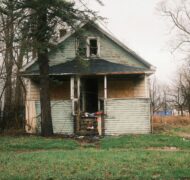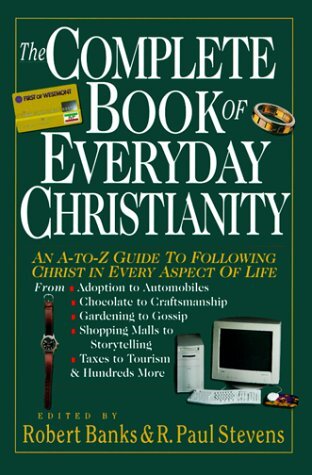Economic Crisis (Written 2011)
Book / Produced by partner of TOW
Prices on homes in America fell dramatically starting in late 2006, after an unprecedented run up in prices over the previous eight years. The fallout from this drop was felt around the world in the worst economic recession since the great depression. Its impact seems to have a long “tail.” For example, global jobless rates remain high five years later. How can the price of a home in Topeka, Kansas, affect jobs and governments a half a world away? What factors came together to cause this to happen? And what can we learn from it? How can we reflect on this as Christians? This is the story we will try to unpack. It is a story of multiple, seemingly unrelated strands which came together as a perfect storm.
What Happened
In the early 1990s, the world was just coming out of a modest recession and a long run of “good times” began. This was the start of the Internet and the “dot com” boom and many nations of the world moved forward economically. In 1995, the U.S. did a major revision of its Community Reinvestment Act, adding fuel to its policies to encourage home ownership for all. This practice has been deeply rooted in government leadership from both political parities. The demand for housing started to increase, hence prices started to increase. The trend for more than half a century of home price escalation of one percent shifted dramatically in 1998 to 7%, a pace that continued until 2006. But the Community Reinvestment Act was only one trigger for this period of growth.
In 1999, the Glass-Steagall Act was repealed. After the great depression, it had been put in place to separate the roles of commercial banks and investment banks, and its repeal allowed any bank to get into the investment business. Some argue this had a minor role in the investment crisis, since provisions of the Act had been eroded steadily beginning in the 1980s, but the timing of this repeal makes it appear as at least one factor in the change of banking behavior.
Another key event came in 2000 with the collapse of the tech bubble. Leading up to that time, any company with “dot com” in its name could attract huge investment. But investors finally began to realize that even with “dot com” in the name, the rules of business had not changed. Companies still needed a viable product and still had to make money in order to survive, and many of these companies were exposed for the shams that they were. The tech market (NASDAQ) dropped from 5000 in early 2000 to almost 1000 a couple of years later, often referred to as the “dot bomb.”
This seemingly unrelated event connected to the housing boom in an interesting way. Investors, seeking a better place to gain growth in their portfolios, responded to the “innovation of the market,” investment products built from mortgages on homes. With the run up of the housing prices, investors could move their money to a new kind of investment vehicle based on the value of homes, including the collateralized debt obligation (CDO).
The first CDOs were created in 1987. A number of mortgages were put together in a package, and then sliced up so that each CDO contained a small piece of many mortgages, reducing the risk of owning a particular mortgage. The value of the investment is represented by the risk of default of the mortgages and the potential increase in value of the homes represented in the package. Not much happened with this market for a number of years, but a spike occurred starting in 2000 and continued until 2007. In the US, a partial factor may have been the repeal of Glass-Steagall. More broadly, these mortgage derivatives looked like the new best opportunity for investment growth after the collapse of the NASDAQ. These packages were purchased by banks all over the world, by pension funds, and other financial institutions. The purchase of these investment vehicles by banks and pension funds around the world is what connected the home price in America to financial holdings in Zurich.
As this market grew, there were not enough mortgages being sold to satisfy the demand for the investment vehicles. This resulted in two things. A new kind of mortgage broker emerged which would loan money for mortgages, but would not keep the loan on its books. Rather, after making the loan it would sell the mortgage to a broker who would package it with other loans to create packages of securitized mortgages. The payment for these mortgages could then be loaned to the next group. Not to be outdone, traditional banks started selling their loans as well. Those selling mortgages were paid on commission, and were not really “bankers.” Their motivation, rather than serving the public as a trustworthy financial intermediary, was to make money by increasing the number of mortgages sold.
Other factors fueled the growth of the sale of mortgages. Interest rates were at an all time low during this period, making a mortgage more attractive. Low interest rates also closed out traditional savings options as a way to grow retirement funds.
To meet the investment demand for more mortgages, new types of loans were created to attract more “home buyers” who may not have qualified for a loan under the old arrangements. The ARMs (adjustable rate mortgages) became one of these instruments, allowing very low interest rates at the beginning (sometimes as low as 3%) with the stipulation they would rise to something higher (say 10%) in five years. They even came with no initial payment, since the lender knew this would attract more buyers and they would be selling the loan anyway, minimizing risk. Since the buyers believed they could resell at a profit before that time, they thought they were limiting their risk as well. And if the buyer actually lived in the home, then they thought they could simply refinance before the higher rate kicked in. More and more people entered the home market because of these favorable terms. But still there was a demand for more mortgages.
Fewer and fewer qualifications were checked on the borrowers, since the market became obsessed with the growth of sales. There were loans that required only the interest to be paid, with nothing paid toward the principal over the first few years. Some even reduced this, resulting in a growth of the debt on the principal. Loans were made on the statement of an individual regarding his or her earnings, requiring no paper work. Not surprisingly, these became known as “liars loans.” Loans were made to buyers who would otherwise not have been considered qualified, and became known as subprime loans.
Assessors, supported by lending institutions, were encouraged to raise the valuation of homes, allowing larger and larger mortgages. Contractors were motivated to build more and more homes since the demand seemed insatiable. The rating agencies also bear significant blame, placing AAA ratings on CDOs made up of pieces of bad mortgages.
On the buyer side, abuses also abounded. Speculators in New York purchased condos in Florida sight unseen, multiples at a time, with the intent of “flipping” them to make money. Poor people bought homes they could not afford (one migrant worker earning $20,000 per year bought a home valued at $1.8 million, according to Michael Lewis in The Big Short).
Not surprisingly, this practice was unsustainable, and as things crashed down, innocent and many not so innocent people got hurt. As home prices started to drop deeply in 2007, the packages that were sold around the world started to fail. The banks and pension funds that owned them and were otherwise highly leveraged started to crumble. The owners who were stuck with multiple houses and condos started to default. Adjustable rate mortgages started to adjust up and people could neither refinance nor sell their homes. When the market stopped buying the mortgage packages, many lenders were stuck with unreasonable and uncollectible mortgages on their books. The lack of available capital and the losses for banks led to losses for businesses that laid off people, sometimes closing altogether. Those who had bet the prices would always go up were caught and punished by the market. Home builders, mortgage brokers, and banks went out of business. Washington Mutual became the largest bank failure in U.S. history to this point, having built its strategy out of vastly increasing its position in subprime loans. The Federal Depositors Insurance Corporation has filed suit against its top officers for reckless leadership. Other long standing investment firms like Merril Lynch and Lehman Brothers were bought for pennies on the dollar with the government’s help. Meanwhile on Mainstreet, unemployment peaked at 10.2% in the U.S. with similar numbers in many parts of the world.
Assessing the risk of a total financial collapse, the many world governments insured bank deposits, leading to deep government debt. The U.S. government put money into automakers, banks, and other institutions to keep them viable, fearing a much broader collapse.
Innocent parties were also hurt. Banks that never entered the subprime business, and held the mortgages they made, found that many people owning homes could no longer make payments. The owners had lost their jobs. Unable to sell the homes which had dropped in value beneath the amount of the loan, the owners walked away leaving the bank holding a mortgage for more than the asset was worth. Those who were duped into buying something more expensive than they could afford lost whatever they had put into the mortgage and were forced out of their homes.
Some not so innocent parties prospered in this mess. Investment banks that bought and sold these toxic packages of bad mortgages sometimes bet against them as well, hedging their own liability while promoting the value of these assets. And in the wake of the crisis, new exploiters have come along. Agents purporting to help those in need are sometimes a front for simply taking money against the promise of helping the impoverished get out of debt and then doing nothing. As in other crises, there are those who step in to help, and those who step in to exploit.
In the aftermath of these events, governments who stepped in to help were punished at the polls. The government of Ireland was toppled early in 2011, the Democrats lost their position of congressional leadership in the U.S., many states in the U.S. are deeply in debt, Greece, Portugal, and other countries have had to be rescued from financial collapse. The crisis has gone deep and wide.
Who is to Blame?
When assessing the cause of all of this, those who point to simple solutions usually line up along the lines of their political parties. For the conservatives, the problem is centered in the Community Reinvestment Act and the goal of home ownership for all, including those who could not afford a home. This liberal policy led to providing mortgages to the poor and created the rapid growth in price and the expansion of home building. They also point to the lax government oversight allowing the market to heat up on the financial side, with poor controls on mortgages. Conservatives also point to the financial bailouts by the government as creating a “moral hazard.” If institutions can operate poorly and be rescued rather than go bankrupt, then why should future companies operate with appropriate caution? If they know they will be later rescued, they will also act recklessly, a behavior the bailouts invite. The market should dictate who wins and who loses. Those who bought homes they could not afford likewise should suffer for their behavior just like those who made bad loans or made bad investments.
Liberals see the picture quite differently. The problem is greedy bankers, mortgage lenders, and home builders out to make as much money as they could, often at the expense of the poor. They point to the huge salaries and bonuses of these company leaders, and the destitute condition of those who lost both their homes and their jobs. These are the victims of greed, and need to be made right. It is the greedy bankers and business leaders who should be punished. Rather than bailing out the banks, the money should have been used to keep poor people in their homes.
Most, however, agree that the truth is more complex than any simple solution can offer. Some borrowers were greedy, and lost their homes (sometimes multiple homes) because of their own bad behavior. But some people who bought homes lacked the education and discernment to stand up to mortgages sales people pushing sales to people who were unqualified. Similarly, some bankers acted honorably, offering quality loans to qualified people only to get caught when homes dramatically lost value and the owners lost their jobs. Few predicted the dramatic financial change that hit the world in 2007 and 2008 as a guide to risk profiles. On the other side, some bankers were truly exploiting the situation for personal gain. Washington Mutual Bank is a clear example of this.
As to the bail outs, this is more difficult than either side cares to acknowledge. Alan Mulally, CEO of Ford (which was the only American automaker not to take a bailout) put it this way. “Two presidents made that judgment call to invest in the automotive industry, and we will never know what would have happened if they hadn’t. Subsequent to that we had the financial meltdown, so it was probably more right than not.”
A Biblical Reflection
There are a number of ways that Christians can reflect on these events, from simple to more profound.
Surely the story of the abuses provides a dramatic illustration to the instructions given by Paul to Timothy in I Timothy 6:10: “For the love of money is a root of all kinds of evil.” Bankers, borrowers, and other players (mortgage companies, builders, assessors), all caught in the pursuit of financial gain, perpetrated enormous pain on the rest of the world. It would be great to say that no Christian leaders were caught in this trap, but that would likely not be true.
Quite a different angle on the story is another dramatic illustration for the average person. Retirement accounts were wiped out, jobs were lost, and homes were lost by people who had nothing directly to do with the problem. This serves as a reminder of what Jesus taught when he said, “Do not store up for yourselves treasures on earth, where moth and rust destroy, and where thieves break in and steal.,” Matthew 6:19. In this day of insured savings accounts and stable banks, many had put this teaching away for a different era, or applied it to people with reckless behavior. But this teaching came home to the 21st century.
Looking deeper at the story, we see the results of business leaders, especially those in financial-related businesses, who put their own bottom line in the number one position. In this sense, there are many parallels with other ethical scandals earlier in the decade, such as the “dot coms” and the surge of failures often associated with “Enron.” In each case, personal short-term gain took priority over customers, products, employees, or even long-term financial gain.
We have studied the Scripture for the purpose of business. We have concluded that in an increasingly interdependent world, with its growing urban population, business plays the unique role of creating, manufacturing, and delivering goods and services in support of its communities. Business has intrinsic value. When its goods and services are life-enabling, it is vital to the flourishing of communities and their people. It is the only institution that creates economic growth, enabling other institutions (government, education, the church, etc.) to be able to function. In addition, along with other institutions, businesses provide an income for workers along with careers enabling people to do meaningful work.
Though the finger of blame can be pointed at more than the leaders of the financial institutions (we have discussed the role of government oversight and gambling behavior on the part of individuals), these leaders contributed significantly to the problems. Roger Lowenstein pointed the finger at Wall Street leaders with this comment in The End of Wall Street: “The proper end of Wall Street is to oil the nation’s business; it became, in the bubble era, a goal [to make money for] itself, a machine wired to inhuman perfection.”
What to Do
The response to this crisis will be a long time in developing. It will include new laws and undoubtedly fines and jail time for the worst offenders. But every new law has a loop hole, and those who look for them will find them. Further, technology will continue to create new situations we have not encountered before, like some of the complex derivatives that were a part of this scandal. Change must start with a transformation of the heart. But even this is not enough. Those Christians with changed hearts must move from personal salvation to the role of disciples, gaining wisdom and understanding about what it is to demonstrate the principles of the Kingdom of God in the circumstances where they are placed. It is the life of integrity, or wholeness, that we are called to. Coming out of the financial crisis, we should renew the full understanding of what it means to live in this way.
Jesus calls us to be “salt and light” in our world. In this increasingly complex world of the 21st century, this starts with seeing everything we do, including our work, as a part of the ministry we have been called to do. It is not time to retreat to the sidelines. Understanding the issues and providing leadership will not make a perfect world. There is brokenness in the hearts of every person, starting with ourselves. But we must seek to make a difference wherever God has placed us. We should come to see each decision we make, even in the ordinary things of life, with a sense of accountability to the whole system under God.
References and Resources
From the long list of books that offer explanations for the financial crisis, these are a few that I have read. They approach the subject from very different perspectives.
All of the Devils are Here: The Hidden History of the Financial Crisis by Bethany McLean and Joe Nocera, 2010
The Battle: How the Fight Between Free Enterprise and Big Government Will Shape America’s Future by Arthur C. Brooks, 2010
The Big Short: Inside the Doomsday Machine by Micheal Lewis, 2010
The End of Wall Street by Roger Lowenstein, 2010
After the Fall: Saving Capitalism From Wall Street—and Washington by Nicole Gelinas, 2009
The 5 Big Lies About American Business: Combating Smears Against the Free-Market Economy by Michael Medved, 2009
Too Big To Fail: The Inside Story of How Wall Street and Washington
Fought to Save the Financial System-and Themselves by Andrew Ross Sorkin, 2009
The Subprime Solution: How Today’s Global Financial Crisis Happened and What to Do About It by Robert J. Shiller, 2008
The 5 Big Lies About American Business: Combating Smears Against the Free-Market Economy by Michael Medved, 2009
Acknowledgments
I am grateful for helpful comments from Brian Griffiths, Prabhu Guptara, John Terrill, and Ross Stewart in their response to the first draft of this article.
—Al Erisman





